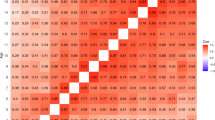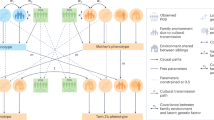Abstract
Background
The heritability of traits such as body mass index (BMI), a measure of obesity, is generally estimated using family and twin studies, and increasingly by molecular genetic approaches. These studies generally assume that genetic effects are uniform across all trait values, yet there is emerging evidence that this may not always be the case.
Method/Subjects
This paper analyzes twin data using a recently developed measure of heritability called the heritability curve. Under the assumption that trait values in twin pairs are governed by a flexible Gaussian mixture distribution, heritability curves may vary across trait values. The data consist of repeated measures of BMI on 1506 monozygotic (MZ) and 2843 like-sexed dizygotic (DZ) adult twin pairs, gathered from multiple surveys in older Finnish Twin Cohorts.
Results
The heritability curve and BMI value-specific MZ and DZ pairwise correlations were estimated, and these varied across the range of BMI. MZ correlations were highest at BMI values from 21 to 24, with a stronger decrease for women than for men at higher values. Models with additive and dominance effects fit best at low and high BMI values, while models with additive genetic and common environmental effects fit best in the normal range of BMI.
Conclusions
We demonstrate that twin and molecular genetic studies need to consider how genetic effects vary across trait values. Such variation may reconcile findings of traits with high heritability and major differences in mean values between countries or over time.




Similar content being viewed by others
Data availability
The FTC data is not publicly available due to the restrictions of informed consent. However, the FTC data is available through the Institute for Molecular Medicine Finland (FIMM) Data Access Committee (DAC) (fimm-dac@helsinki.fi) for authorized researchers who have IRB/ethics approval and an institutionally approved study plan. To ensure the protection of privacy and compliance with national data protection legislation, a data use/transfer agreement is needed, the content and specific clauses of which will depend on the nature of the requested data.
References
Benn R. Some mathematical properties of weight-for-height indices used as measures of adiposity. Br J of Prev & Soc Med. 1971;25:42.
Must A, Spadano J, Coakley EH, Field AE, Colditz G, Dietz WH. The disease burden associated with overweight and obesity. JAMA. 1999;282:1523–9.
Elks CE, Den Hoed M, Zhao JH, Sharp SJ, Wareham NJ, Loos RJ, et al. Variability in the heritability of body mass index: a systematic review and meta-regression. Front in endocrinol. 2012;3:29.
Maes HH, Neale MC, Eaves LJ. Genetic and environmental factors in relative body weight and human adiposity. Behav genet. 1997;27:325–51.
Riveros-McKay F, Mistry V, Bounds R, Hendricks A, Keogh JM, Thomas H, et al. Genetic architecture of human thinness compared to severe obesity. PLoS genet. 2019;15:e1007603.
Price A, Stunkard AJ. Commingling analysis of obesity in twins. Hum Heredity. 1989;39:121–35.
Williams PT. Quantile-dependent heritability of computed tomography, dual-energy x-ray absorptiometry, anthropometric, and bioelectrical measures of adiposity. International Journal of Obesity. 2020;44:2101–12.
Berentsen GD, Azzolini F, Skaug HJ, Lie RT, Gjessing HK. Heritability curves: a local measure of heritability in family models. Stat in Med. 2021;40:1357–82.
Hjelmborg JV, Fagnani C, Silventoinen K, McGue M, Korkeila M, Christensen K, et al. Genetic influences on growth traits of BMI: a longitudinal study of adult twins. Obesity. 2008;16:847–52.
Kaprio J, Bollepalli S, Buchwald J, Iso-Markku P, Korhonen T, Kovanen V, et al. The older Finnish Twin Cohort—45 years of follow-up. Twin Res and Hum Genet. 2019;22:240–54.
Khoury MJ, Beaty TH, Beaty TH, Cohen BH. Fundamentals of genetic epidemiology, vol. 22. Monographs in Epidemiology and, 1993.
Falconer DS. Introduction to quantitative genetics, Oliver & Boyd:Edinburgh/London, 1960.
Bjerve S, Doksum K. Correlation curves: measures of association as functions of covariate values. The Annals of Statistics. 1993;21:890–902.
Kristensen K, Nielsen A, Berg CW, Skaug H, Bell B. TMB: automatic differentiation and Laplace approximation. 2015:arXiv preprint arXiv:1509.00660.
Silventoinen K, Jelenkovic A, Sund R, Yokoyama Y, Hur Y-M, Cozen W, et al. Differences in genetic and environmental variation in adult BMI by sex, age, time period, and region: an individual-based pooled analysis of 40 twin cohorts. The Am J of clin nutr. 2017;106:457–66.
Khera AV, Chaffin M, Wade KH, Zahid S, Brancale J, Xia R, et al. Polygenic prediction of weight and obesity trajectories from birth to adulthood. Cell. 2019;177:587–96. e9.
Naukkarinen J, Rissanen A, Kaprio J, Pietiläinen KH. Causes and consequences of obesity: the contribution of recent twin studies. Int J of Obes. 2012;36:1017–24.
van der Kolk BW, Saari S, Lovric A, Arif M, Alvarez M, Ko A, et al. Molecular pathways behind acquired obesity: Adipose tissue and skeletal muscle multiomics in monozygotic twin pairs discordant for BMI. Cell Rep Med. 2021;2:100226.
Kaur Y, De Souza R, Gibson W, Meyre D. A systematic review of genetic syndromes with obesity. Obes Rev. 2017;18:603–34.
Seidell JC, Flegal KM. Assessing obesity: classification and epidemiology. Br med bull. 1997;53:238–52.
Collaborators GO. Health effects of overweight and obesity in 195 countries over 25 years. New Engl J of Med. 2017;377:13–27.
Mitchell JA, Hakonarson H, Rebbeck TR, Grant SF. Obesity‐susceptibility loci and the tails of the pediatric BMI distribution. Obesity. 2013;21:1256–60.
Beyerlein A, von Kries R, Ness AR, Ong KK. Genetic markers of obesity risk: stronger associations with body composition in overweight compared to normal-weight children. Plos one. 2011;6:e19057.
Abadi A, Alyass A, du Pont SR, Bolker B, Singh P, Mohan V, et al. Penetrance of polygenic obesity susceptibility loci across the body mass index distribution. The Am J of Hum Genet. 2017;101:925–38.
Rokholm B, Silventoinen K, Ängquist L, Skytthe A, Kyvik KO, Sørensen TI. Increased genetic variance of BMI with a higher prevalence of obesity. PloS one. 2011;6:e20816.
Nan C, Guo B, Warner C, Fowler T, Barrett T, Boomsma D, et al. Heritability of body mass index in pre-adolescence, young adulthood and late adulthood. Eur J of epidemiol. 2012;27:247–53.
Silventoinen K, Rokholm B, Kaprio J, Sørensen TI. The genetic and environmental influences on childhood obesity: a systematic review of twin and adoption studies. Int J of obes. 2010;34:29–40.
He L, Sillanpää MJ, Silventoinen K, Kaprio J, Pitkäniemi J. Estimating modifying effect of age on genetic and environmental variance components in twin models. Genetics. 2016;202:1313–28.
Silventoinen K, Jelenkovic A, Sund R, Hur Y-M, Yokoyama Y, Honda C, et al. Genetic and environmental effects on body mass index from infancy to the onset of adulthood: an individual-based pooled analysis of 45 twin cohorts participating in the COllaborative project of Development of Anthropometrical measures in Twins (CODATwins) study. The Am J of Clin Nutr. 2016;104:371–9.
Choh AC, Lee M, Kent JW, Diego VP, Johnson W, Curran JE, et al. Gene‐by‐age effects on BMI from birth to adulthood: the Fels longitudinal study. Obesity. 2014;22:875–81.
Silventoinen K, Kaprio J, Yokoyama Y. Genetic regulation of pre-pubertal development of body mass index: a longitudinal study of Japanese twin boys and girls. Behav genet. 2011;41:234–41.
Silventoinen K, Pietiläinen KH, Tynelius P, Sørensen TI, Kaprio J, Rasmussen F. Genetic regulation of growth from birth to 18 years of age: the Swedish young male twins study. Am J of Hum Biol. 2008;20:292–8.
Ortega-Alonso A, Pietiläinen KH, Silventoinen K, Saarni SE, Kaprio J. Genetic and environmental factors influencing BMI development from adolescence to young adulthood. Behav genet. 2012;42:73–85.
Acknowledgements
Parts of this work have been done in the context of CEDAS (Center for Data Science, University of Bergen, Norway).
Author information
Authors and Affiliations
Contributions
FA, GDB, HJS and JBH contributed to the conception and design of the work. JBH and JAK provided the data material. FA carried out all statistical analyses. FA drafted the manuscript, except for sections Introduction and Discussion which were drafted by JAK. All authors participated in finalizing the manuscript and gave final approval and agreed to be accountable for all aspects of work ensuring integrity and accuracy.
Corresponding author
Ethics declarations
COMPETING INTERESTS
The authors declare no competing interests.
Additional information
Publisher’s note Springer Nature remains neutral with regard to jurisdictional claims in published maps and institutional affiliations.
Supplementary information
Rights and permissions
About this article
Cite this article
Azzolini, F., Berentsen, G.D., Skaug, H.J. et al. The heritability of BMI varies across the range of BMI—a heritability curve analysis in a twin cohort. Int J Obes 46, 1786–1791 (2022). https://doi.org/10.1038/s41366-022-01172-6
Received:
Revised:
Accepted:
Published:
Issue Date:
DOI: https://doi.org/10.1038/s41366-022-01172-6
- Springer Nature Limited




